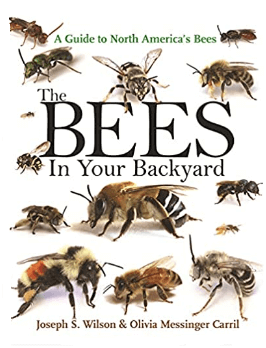In this article:
What Are Ground Bees?
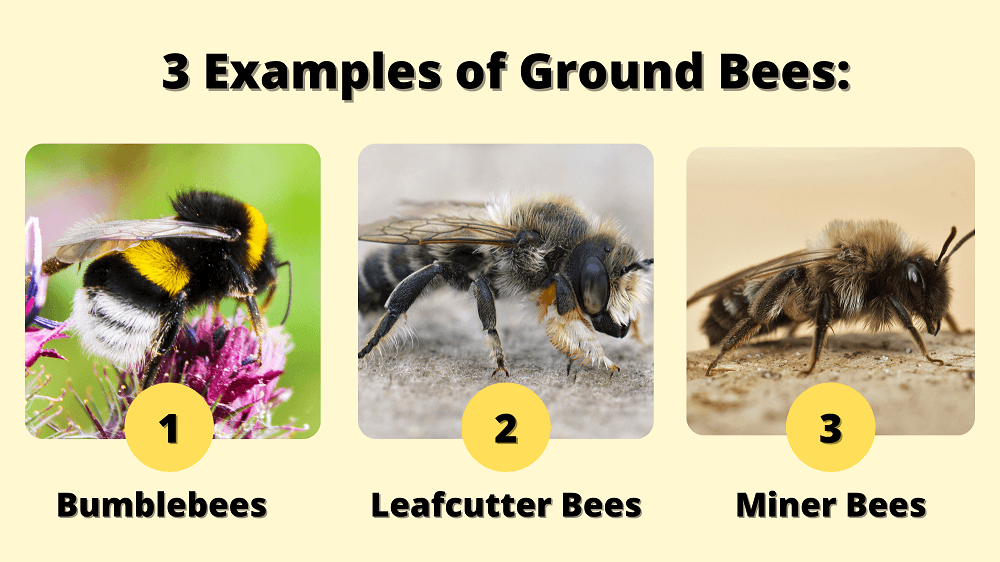
To put it simply:
Ground bees are bees that build their nests in soil.
But here’s the kicker:
A staggering 70% of bee species nest underground in the United States.(1, 2)
So “ground bee” is a broad term that refers to various ground-nesting bees.(3, 4)
The most well-known ground bees are:
- Miner bees
- Yellow-faced bees
- Bumblebees
- Silvery leafcutter bees
- Sweat bees
But now let’s get one big question cleared up:
Are Ground Bees Harmful?
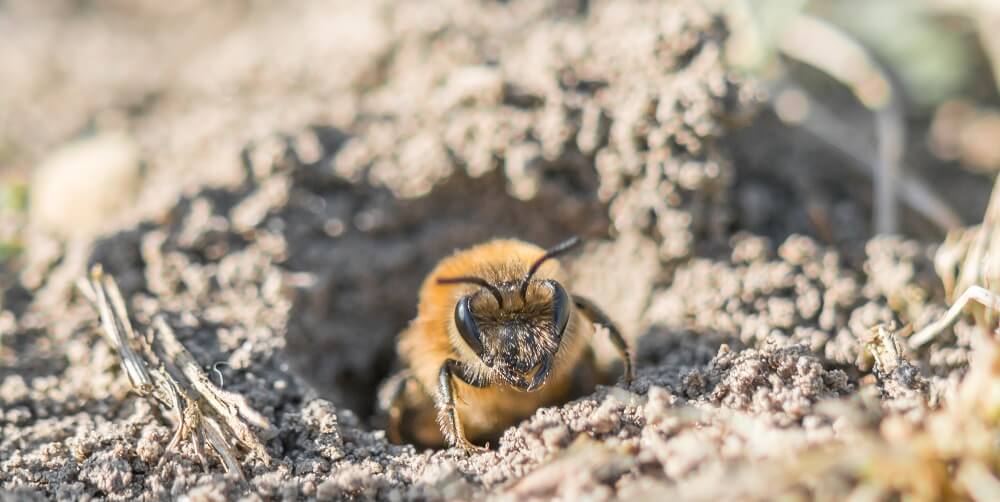
Don’t worry.
Ground bees are in no way harmful to you or your yard.
In fact, the opposite is true.
Many species of ground bees can actually improve your yard.
For starters, ground bees dig small holes that help aerate your grass. Aerated grass allows essential nutrients, water, sunshine, and air to seep down into the roots. This helps your lawn grow a strong, healthy root system that is more resistant to weeds.
And here’s the thing:
It’s recommended to aerate your lawn yearly.
Aeration is especially important if your lawn gets a lot of foot or car traffic. The increased weight and pressure from cars, pets, and people can compact your grass.
Thankfully, ground bees can help relieve extra stress and tension from your lawn by aerating it.

Ground bees are also crucial pollinators that gather nectar and pollen from flowers. According to the USDA, pollinators are responsible for 1 in 3 bites of food we eat.(5)
And good news:
After the spring nesting season, rain will wash the soil back into place and cover the ground bees’ nesting holes.
Now you might be asking:
Do ground bees sting?
They can, but in most cases, they won’t. Ground bees are typically solitary bees that are gentle. They pose little threats to humans or animals.
While the males are extremely active and can sometimes appear aggressive, they don’t have a stinger, so they can’t sting you. Only the females have stingers, but their passive nature usually prevents them from stinging.
Chances are?
If you see a ground bee buzzing around you, they’re probably just exploring or curious.
How to Get Rid of Ground Bees
After spring is over, most ground bees will go away on their own. And then the rain will hit and cover up their holes.
With that in mind, the best way to deter ground bees is to do it naturally. Don’t use pesticides or chemicals of any kind, as that can harm kids, pets, and other wildlife.
Here are two tips for deterring ground bees:
Tip 1: Water your soil

Bees prefer dry soil.
Simply watering your yard will deter bees from nesting in it. And if you see a lot of ground bees returning to your lawn year after year, run a sprinkler over it right before spring hits.
You can use a sprinkler that hooks up to your garden hose to make things easier. It does all the work for you.
It’s also important to mention:
Most ground bees don’t dig their nests in thick, well-kept lawns. They prefer dry soil with easy access to the nest entrance.
Related: How Long Do Bumble Bees Live?
Tip 2: Sprinkle cinnamon over your yard

Bees may enjoy sweet foods, but they don’t like cinnamon.
Your best bet is to grab a large container of cinnamon and sprinkle it generously over your yard. Do this 2-3 times per week for a few weeks.
And don’t forget:
Try to do this before spring hits so you can deter the bees before they start nesting.
However, if spring is already here, you can still use cinnamon to encourage the bees to relocate.
But that’s not recommended.
It’s best to leave the nests alone and wait until next year to sprinkle cinnamon. You don’t want to disturb the baby bees.
Remember:
Ground bees are crucial pollinators. We need them in the ecosystem.
FAQs about Ground Bees:
- How deep are ground bee nests?
- Can you drown ground bees?
- How long do ground bees stay around?
- Do ground bees make honey?
- Are ground bees the same as yellow jackets?
- Do ground bees sting?
- Why do I have ground bees?
- How many types of ground bees are there?
- Are ground bees good?
- Can bees dig through dirt?
- What do I do for ground bee removal?
How deep are ground bee nests?
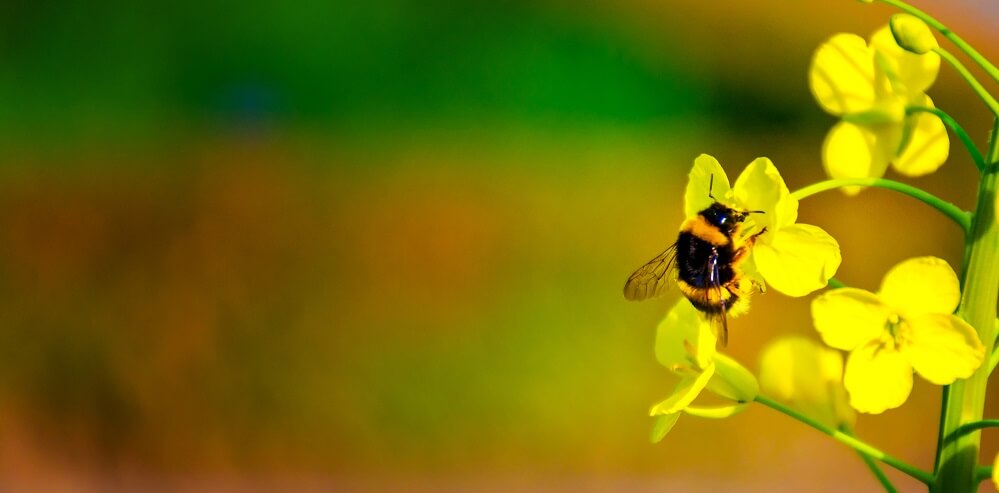
The majority of nests are between 6 and 16 inches deep, although some bee tunnels have been found to extend several feet below the earth’s surface.
Bumblebees’ nests, for example, are built in pre-existing holes like empty mouse burrows. These burrows can be anywhere from 18 inches to 3 feet deep.
Most ground bees then fill these burrows by laying an egg, pushing in a ball of pollen and nectar, and sealing the hole. The baby bee will eat the pollen for food.
—> Go back to the FAQs about ground bees
More to Explore:
Can you drown ground bees?
Yes.
You see, bees can’t swim, so flooding your grass with too much water can drown them.
Ground bees are important pollinators, so we don’t recommend flooding their nests.
Instead, sprinkle cinnamon around the area to deter them. You can also set out sprinklers to lightly wet the area, which will also help repel ground bees.
—> Go back to the FAQs about ground bees
More to Explore:
How long do ground bees stay around?
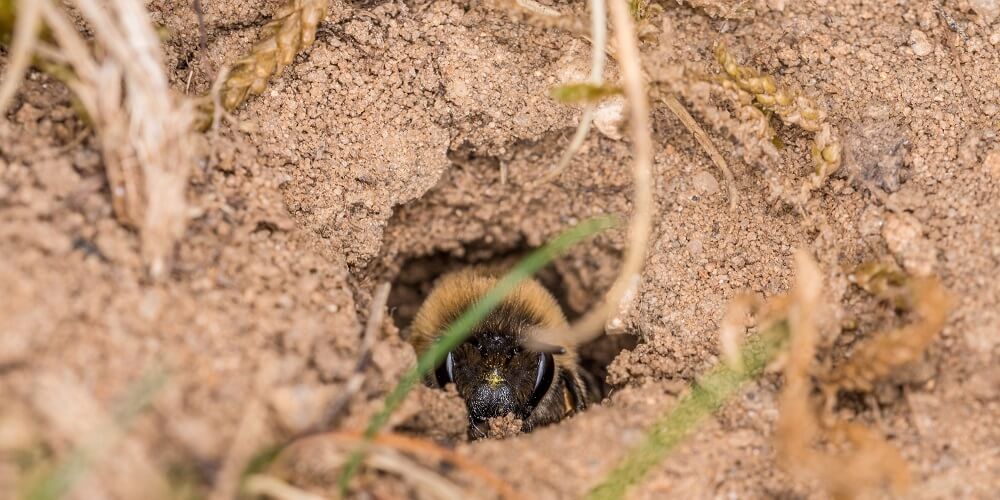
Ground bees usually stick around for 4-6 weeks during the spring, and then they disappear until next year.
Once they disappear, the rain will usually wash dirt over the holes and cover them up.
But if you want to get rid of ground bees, do so naturally. Don’t harm or try to kill these important pollinators. Instead, regularly water your soil before the bees become active in the spring. Ground bees prefer dry soil, so they’ll avoid nesting in your yard if it’s damp.
As mentioned, you can also try sprinkling cinnamon in your yard. Bees don’t like the scent of cinnamon.
—> Go back to the FAQs about ground bees
More to Explore:
Do ground bees make honey?
In most cases, no. Honeybees are the only bees known for making the honey that you can get from a beekeeper, grocery store, or local farmers’ market.
There are exceptions to this, though.
For example, bumblebees are considered ground bees because they nest underground. Bumblebee hives make small amounts of honey to tide them over when needed.(6)
For more information, read our article: Do Bumblebees Make Honey?
—> Go back to the FAQs about ground bees
More to Explore:
Are ground bees the same as yellow jackets? Are ground bees wasps?

Nope, while some ground bees resemble yellow jackets, they aren’t the same.
Ground bee vs. yellow jacket:
The yellowjacket and other wasps have more slim bodies, whereas bees appear plumper in comparison. Also, yellow jackets sometimes get confused with honeybees.
While they look similar, honeybees have “pollen baskets” that yellow jackets don’t have.
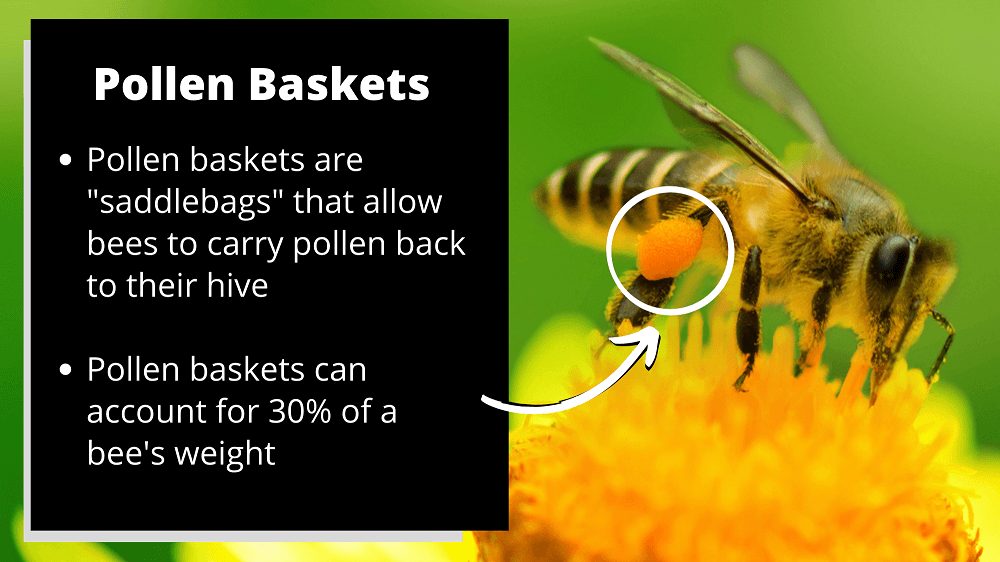
Yellowjackets are generally brightly colored and have distinct black and yellow markings.
You also may tell the difference between bees and yellowjackets by their behavior.
Since bees collect pollen and nectar, they’re more likely to be seen hovering around flowers. Yellowjackets are pollinators too, but they also forage for garden pests to feed their babies.
—> Go back to the FAQs about ground bees
More to Explore:
Do ground bees sting? Can ground bees sting multiple times?
It depends.
For one, only female bees have stingers. Male bees do not. Stingers are actually modified egg-laying devices for female bees, so they aren’t needed by males.
But that said, while female ground bees can sting you, they’re unlikely to do so. Despite popular belief, most bees are gentle and just prefer to be left alone.
Here’s the bottom line:
Bees don’t sting unless provoked to the point where they feel seriously threatened. This is why you shouldn’t poke your hands around a beehive or try to grab a bee.
Ground bees can sting multiple times, but again, they’re unlikely to do so. They mostly just mind their business.
—> Go back to the FAQs about ground bees
More to Explore:
Why do I have ground bees?
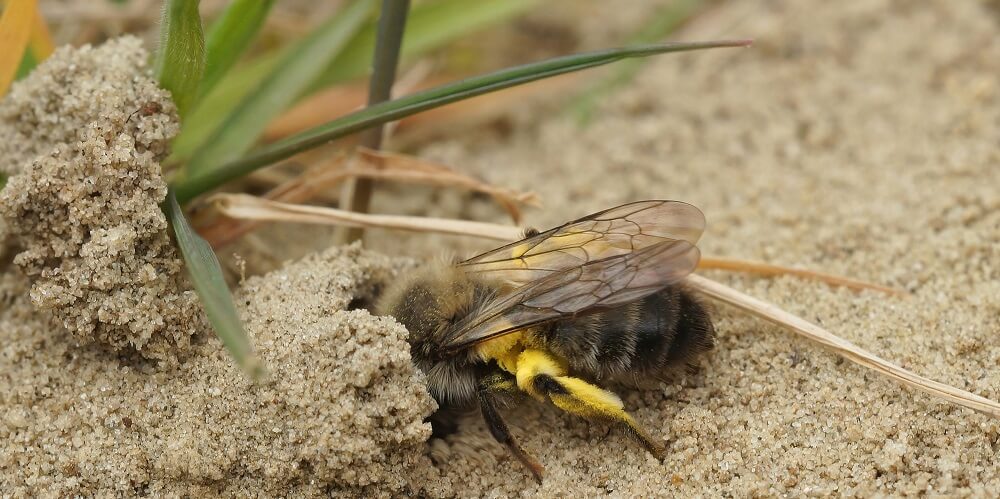
People often ask, “Why are bees all over my lawn?”
The answer is that, in the US, 70% of bee species nest in the ground.(7, 8)
That’s why it’s not uncommon to see small holes with bees in them. They need somewhere to nest and raise their young. Most bees prefer to remain out of sight and don’t want to be bothered.
Ground nesting bees also have an important ecological function, as they pollinate both agricultural plants and wildflowers. They’re not harmful because they’re unlikely to sting. They’re also beneficial to lawns because they create holes that help aerate your yard.
Once summer arrives, ground bees are usually through nesting, and the holes get covered up once it rains.
—> Go back to the FAQs about ground bees
More to Explore:
- How to Get Rid of Carpenter Bees Naturally?
- How Many Eyes Does a Bee Have?
- How Many Legs Do Bees Have?
How many types of ground bees are there?
There are thousands of ground bees in the United States alone.(9)
So, what type of bees are ground bees?
Well, most bees are solitary bees that nest in the ground or in pre-existing holes from rodents or other animals. Here are a few popular types of ground-nesting bees:
- Bumblebees
- Sweat bees
- Miner bees
- Leafcutter bees
- Alkali bee
You might be thinking:
What about aggressive ground bees? Is there such a thing?
No, ground bees are not aggressive. They have a passive and gentle nature. In most cases, they aren’t territorial. They just prefer to be left alone.
People often mistake yellow jackets for “aggressive ground bees,” but they’re not the same. Bees and yellow jackets are sometimes difficult to differentiate. Both can sting, fly, and both belong to the same order of insects, Hymenoptera.
That said, bees and yellow jackets have many differences in terms of aggressiveness, physicals characteristics, diet, and sociability.
—> Go back to the FAQs about ground bees
More to Explore:
Are ground bees good?

Yes, they are.
People often wonder, “Should I get rid of ground bees?”
No, because ground bees are beneficial to your yard and garden. They’re also gentle-natured, so you don’t usually have to worry about a ground bee stinging you.
Let’s talk about a few benefits of ground bees:
For starters, ground bees dig little holes that help aerate your lawn. Aerating your lawn allows vital nutrients, water, sunshine, and air to seep down into the grass root system. This will assist your lawn in growing a strong, healthy root system that is more resistant to unwanted weeds and grasses.
It’s recommended that homeowners aerate their lawn once per year.
This is especially vital if your lawn gets a lot of foot traffic. Increased foot traffic from pets, family, and friends can compact your lawn due to the weight and pressure. Aerating your lawn relieves extra stress and tension, allowing it to flourish.
Secondly, ground bees pollinate blossoms which is crucial to the survival of more than 50% of flowering plants.(10, 11)
And since pollinators are responsible for 1 in 3 bites of food we eat, pollinators like ground bees are beneficial to humans.(12)
—> Go back to the FAQs about ground bees
More to Explore:
Can bees dig through dirt?
Yes.
Many species of bees will dig through dirt to build their nests. “Ground bees” is a general term to describe them.
They usually burrow down 2 to 6 inches into the soil, leaving small piles of dirt outside of the hole. Most ground bees are solitary bees that live alone. While they don’t form hives, several other ground bees may nest in the same location.
Ground bees typically nest in the spring, and once the summer arrives, their young have hatched, and their holes get covered when it rains.
—> Go back to the FAQs about ground bees
More to Explore:
- How to Keep Bees Away From Hummingbird Feeders
- Do Honey Bees Sting?
- Wasps vs. Honeybees: How Are They Different?
What do I do for ground bee removal?
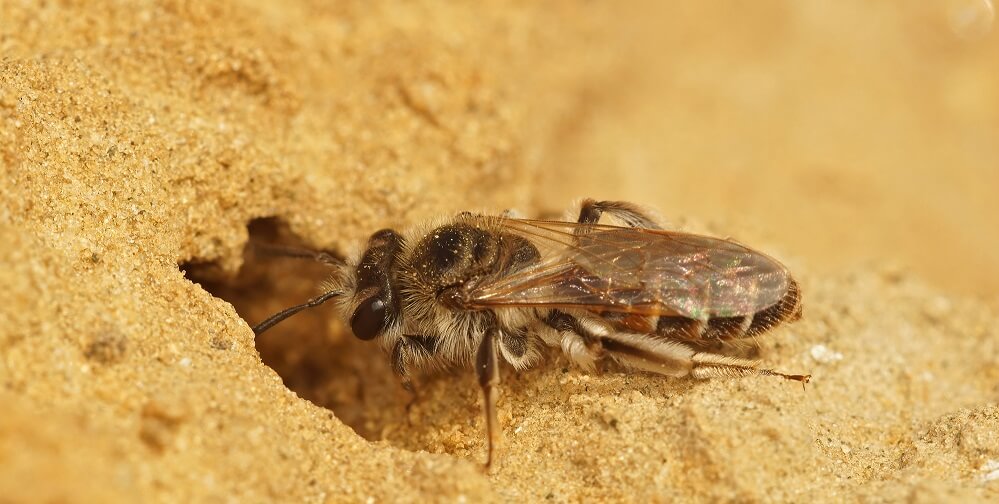
Common questions we get include:
How do I get rid of ground bees? Is there a ground bees killer powder, ground bee spray, or ground bee insecticide?
The answer is that you shouldn’t try to remove ground bees. They’re beneficial bees that help aerate your yard and pollinate local crops.
But if you must, the best way to remove ground bees is to moisten your grass. Most ground bees prefer to nest in dry soil, so wetting your lawn or using a sprinkler system will deter them.
You can also sprinkle cinnamon generously over areas where they typically nest. Do this before spring hits and before they start nesting.





